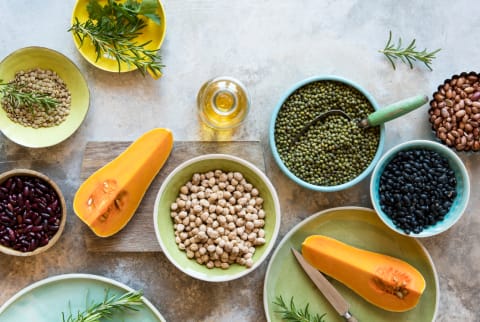Advertisement
8 Easy Ways To Add More Vegetarian Protein To Your Day


Though most of us do just fine meeting our needs, sometimes it can be a challenge to work protein in consistently throughout the day. I find that many of my clients who complain of feeling hungry are falling a little short of their goal or having most of their protein at one meal rather than spreading it out throughout the day. This also comes up when someone is transitioning to a plant-based diet that involves less of the animal proteins they’re used to.
The Academy of Nutrition and Dietetics recommends 0.8 to 1.0 grams of protein per kilogram of body weight for most healthy adults. For a 150-pound person, that’s about 55 to 68 grams of protein per day. Vegetarians should aim for the higher end of that range, since they may need slightly more grams of protein coming from different plant sources to cover their bases for all the essential amino acids we need, since most plant foods contain only a few, whereas animal proteins contain all nine. Things like activity level, age, and certain medical conditions or medications can affect our needs. People who are very active, for example, may need more. During pregnancy and lactation or when healing from surgery or an injury, needs also increase.
While we’re talking high protein foods, can we please kill the myth that avocados are a good source? I have no idea where it started, but it confuses the heck out of people. Yes, avocados contain protein, but only about 1 gram per serving. Ideally, you want to aim for at least 15 grams per meal—that would take a lot of avocado!
The good news is that adding protein throughout the day can make it easy to meet your needs. Make protein powder, bars, and fortified foods your last resorts instead of staples, and instead, try these easy real-food approaches to up your protein intake:
1. Hemp hearts:
Instead of croutons, top your soup or chili with a generous spoonful of hemp hearts. Each tablespoon provides about 3 grams.
2. Roasted chickpeas:
Another great soup topper, roasted chickpeas also make a great addition to salads and grain bowls or even enjoyed on their own as a handy snack. They’re easy to DIY—just toss with a little olive or coconut oil and your favorite spices and roast at 375°F until crispy, about 20 to 30 minutes. A half-cup adds about 7 grams of protein.
3. Nutritional yeast:
It sounds kind of funky to the uninitiated, but nutritional yeast is super-convenient for adding protein to all kinds of foods. Its pleasant, savory taste makes is a nice complement to many flavors. Shake it over salad, pasta, grain bowls, or popcorn. You can also use it to make a vegan "cheese" sauce by cooking it with nondairy milk and savory spices.
4. Puréed tofu:
Puréed tofu is a great way to bulk up smoothies, baked goods (vegan cheesecake, anyone?), or soup. My personal favorite take is to combine it with pumpkin or butternut squash purée and add miso paste, garlic powder, and turmeric. Toss this sauce with cooked chickpea pasta for a nourishing vegan take on mac & cheese.
5. Put an egg on it:
One large egg provides about 6 grams of high-quality protein. I love to top lentil soup, a bowl of beans and veggies, or even savory oatmeal with a poached egg. Hint: It’s a great way to elevate your avocado toast. Cooking in an egg also adds a fluffy texture and rich taste to a humble bowl of oatmeal.
6. Swap your yogurt:
Because they’re strained, Greek yogurt and Icelandic skyr offer up as much as double the protein content of regular yogurt. One cup can have as much as 20 grams! Just skip the sweetened stuff. It’s also a great sub for mayonnaise or sour cream in recipes.
7. Rethink cottage cheese:
Cottage cheese has a reputation as an old-school "diet" food, but there are some seriously delish cultured, organic options on the market. Not into it? Try ricotta. Its smooth texture and versatile flavor give you endless options. Both cottage cheese and ricotta contain about 6 to 8 grams of protein per quarter-cup. They make great toast toppers instead of cream cheese or butter, and they also add staying power to a smoothie or oatmeal (stir in at the end). If you’ve never tried ricotta on top of pancakes, you’re welcome.
8. Swap out your grains:
Instead of whole wheat pasta or a whole grain like brown rice or barley, try a lentil or bean-based pasta or a serving of beans or lentils as your carb for the meal. You’ll get tons of fiber and lots of protein to keep you satiated.
Wanna add in some protein powder? These are the healthiest options.